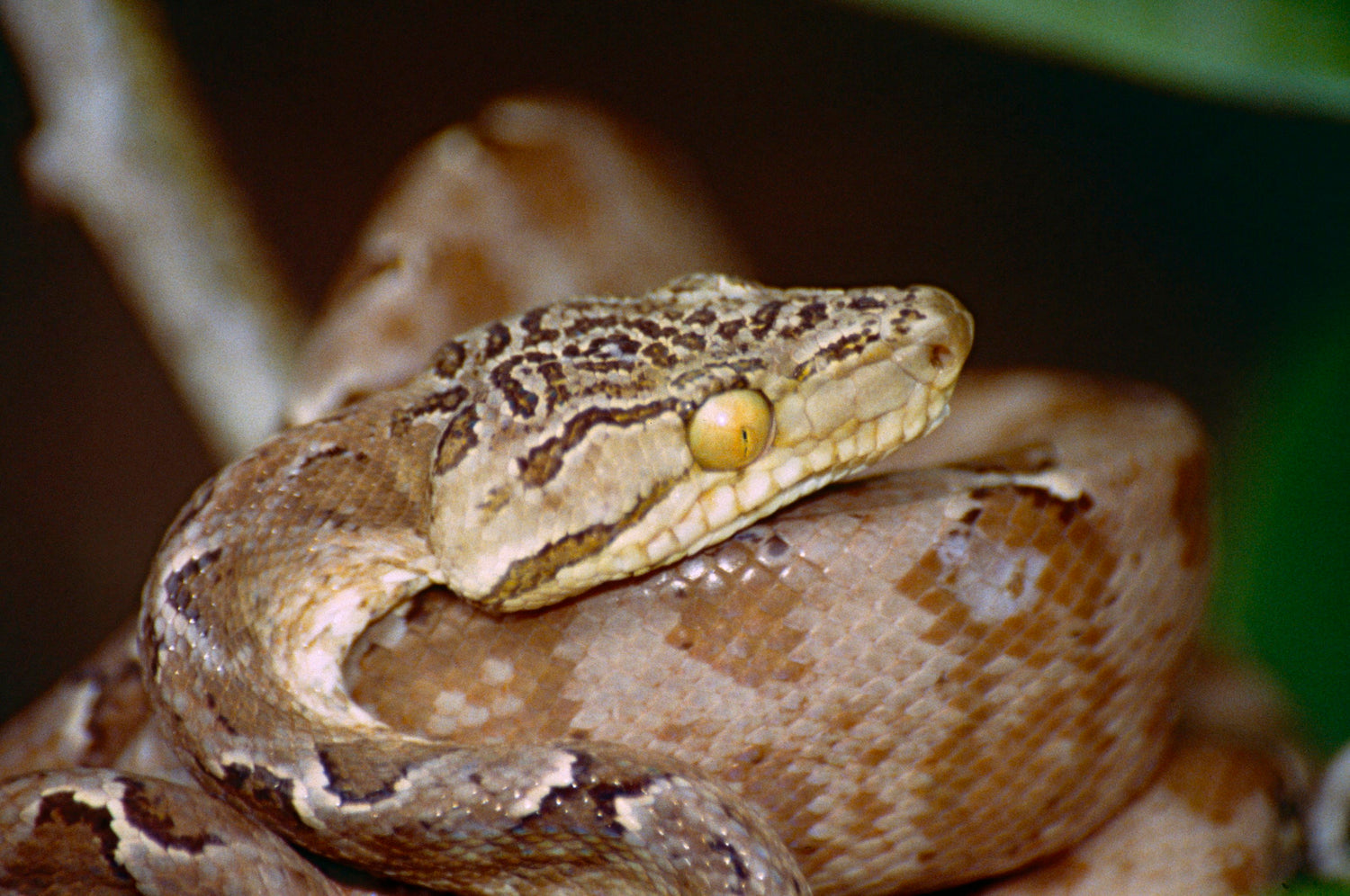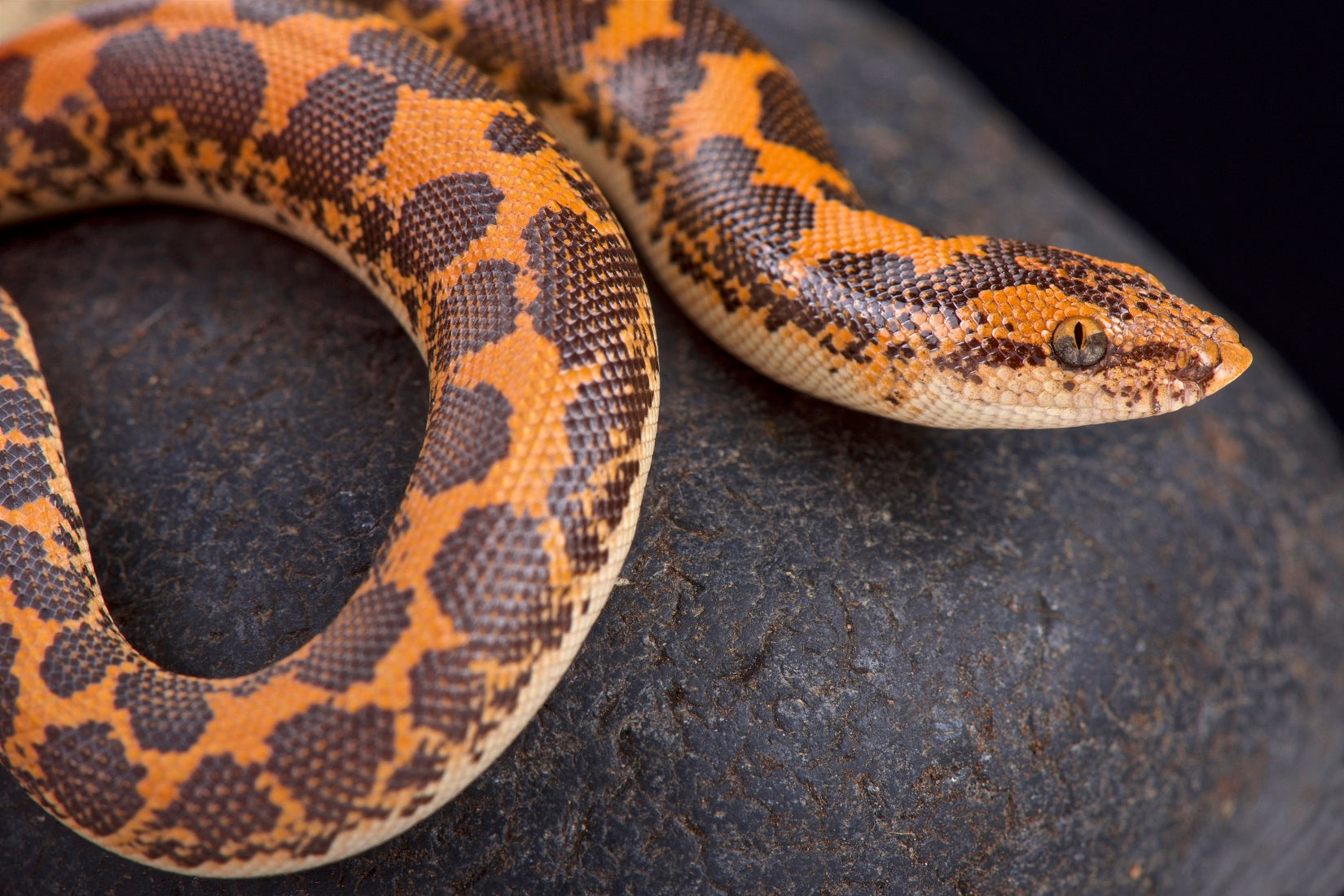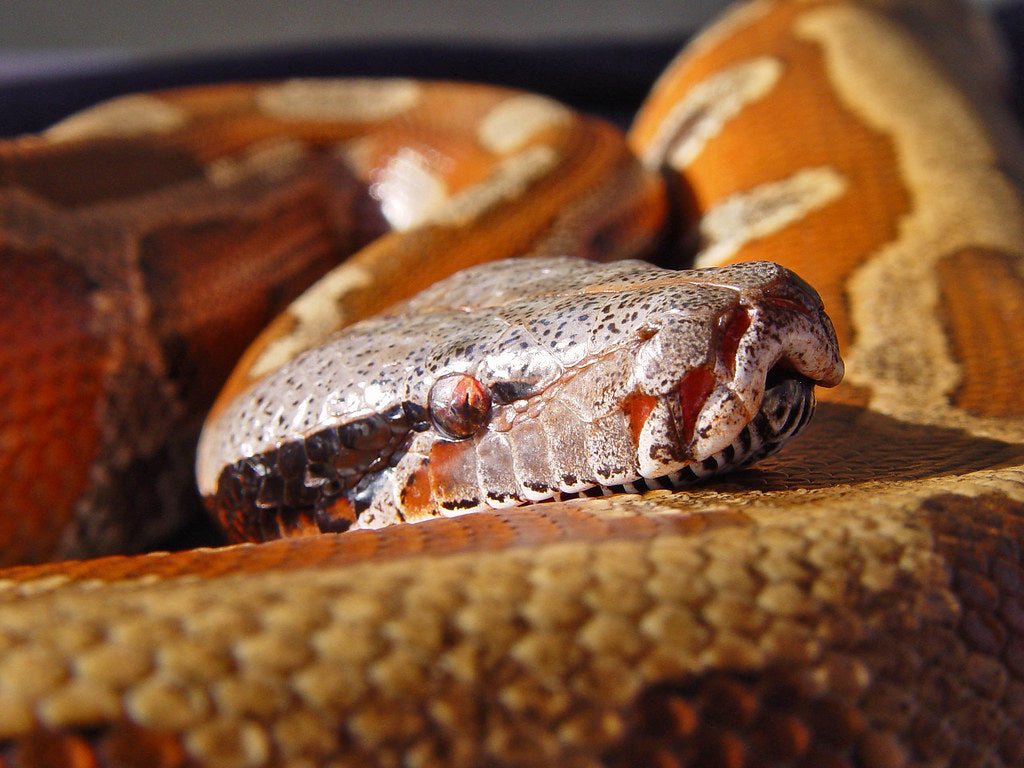Amazon tree boas (Corallus hortulanus) are medium-sized, arboreal snakes native to the neotropics of South America. They tend to prefer tropical rainforest for habitat, but they can also be found in drier areas such as savannah and dry forest. As an arboreal species, they spend more of their time in trees.
Amazon tree boas typically grow to about 5’ long, although some are known to grow larger. They have a large head, slim body, and large, well-defined infrared pits along their lips. Amazon tree boas are best known for their stunning array of colors, and patterns are often a combination of brown, gray, yellow, orange, and red.
Amazon tree boas are highly defensive toward humans, which makes them an advanced-level pet reptile. They are wonderful to look at, but are usually very difficult to tame. With good care, however, they make beautiful display animals that can live up to 20 years.
How much space do Amazon tree boas need?
Because Amazon tree boas are slender, it’s easy to think of them as smaller than they really are, keeping them in enclosures that are too small for them to stretch out fully, explore, and climb. The minimum for appropriately keeping one adult Amazon tree boa is 48”L x 24”W x 48”H. This is just the minimum, so using larger dimensions is beneficial and will happily be used!
Cohabitation (keeping multiple Amazon tree boas in one enclosure) is not recommended, as this is not a social species, and keeping them together causes competition and stress.
Do Amazon tree boas need UVB?
They seem to be able to survive without it, but it’s still best practice to provide UVB lighting for optimal health and wellbeing. Amazon tree boas are active during both the day and night, which means that it’s very likely they actively bask in sunlight during the day. Providing UVB lighting to your snake gives them all of the vitamin D that their body needs, stimulates better appetite and activity, and generally allows them to be healthier than they would be without.
The best UVB bulbs for Amazon tree boas housed in a 48” x 24” x 48” enclosure are:
- Zoo Med Reptisun T5 HO 5.0, 34”
- Arcadia Forest 6%, 34”
The UVB bulb should be housed in a reflective fixture like the Arcadia ProT5 or Vivarium Electronics, and placed close to the heat lamp, about 11-13” above the basking branch if over mesh, and 14-16” above the basking branch if not. UVB is blocked by glass and plastic, so you can’t give your snake UVB by placing its terrarium in front of an open window. Also make sure that the fixture your UVB bulb is in does not have a clear plastic bulb cover. UVB bulbs decay over time, so don’t forget to replace your bulb every 12 months to maintain good performance.
Lights should be on for 12 hours/day.
What basking temperatures do Amazon tree boas need?
Like other reptiles, Amazon tree boas are ectotherms, which means that they need a temperature gradient in their enclosure to help them regulate their metabolism and stay healthy.
Amazon tree boas need a basking air temperature between 89-92°F. On the other side of the enclosure, the temperature should be around 75°F. Measure air temperatures in these locations with a digital probe thermometer, with the probe placed in the desired area.
Because Amazon tree boas are arboreal, heat mats don’t work for heating them. Instead, provide heat for your snake by imitating the sun with a halogen heat lamp placed on one side of the enclosure, positioned over a sturdy basking branch or warm hide. Do not use ceramic heat emitters (CHEs), red bulbs, or blue bulbs, as these are not as effective.
If the heat lamp is not enough to get the warm hide to an appropriate temperature, use a heat mat connected to a thermostat to control the warm hide temperature.
What humidity levels do Amazon tree boas need?
Amazon tree boas dehydrate easily, and need an average humidity of 60-80%, as measured by a digital probe hygrometers placed in the middle of the enclosure. It’s helpful to install a humid hide for your snake in the upper portions of the terrarium, lined with moistened sphagnum moss. Always having a humid retreat is essential.
Misting your snake’s enclosure with a sprayer first thing in the morning and again at night will help create the right humidity levels. If you need more, installing a cool mist humidifier connected to a hygrostat can be helpful.
These snakes also tend to like soaking after a meal, so make sure to provide a tub of water large enough to accommodate their entire body. Keep the water in this tub clean at all times, and scrub with animal-safe disinfectant once a week.
What substrate is good for Amazon tree boas?
Amazon tree boas require a thick layer of moisture-retentive substrate to cushion their bodies and help maintain healthy humidity levels. As an added perk, it also tends to make the enclosure more attractive.
Ideally, this substrate should resemble what Amazon tree boas naturally live on in the wild: soil. It should have small particles and hold moisture well. We recommend the following substrates for Amazon tree boas:
Layering clean, chemical-free leaf litter on top of the substrate can also help with humidity.
Substrate should be at least 4” deep and completely replaced every 3-4 months. Remove poop and urates daily, along with contaminated substrate.
What décor can you use in an Amazon tree boa terrarium?
It’s terribly boring for a snake to be stuck in an enclosure with nothing in it except substrate, a branch, and a water bowl. It doesn’t matter how big the enclosure is if you don’t put things in it for your pet to use and interact with.
Since Amazon tree boas are arboreal, branches are a VERY important thing to include in their enclosure! These branches should be about as thick as the thickest part of the snake’s body, and they should be placed so they intersect so the snake can have multiple points of contact. (Branches with lots of forks in them are great!)
Additional décor options include:
- thick vines
- cork tubes
- ledges
- live or artificial plants
Whatever you choose to use, make sure that the snake has cover to hide in so it can feel secure in its environment.
What do Amazon tree boas eat?
Like other snakes, Amazon tree boas are carnivores, which means that they need to eat whole animal prey in order to get the nutrition that they need. Here is a basic feeding schedule based on snake size:
- Hatchlings and juveniles (<2 years old) should be fed once every 7-10 days.
- Subadult and adults (>2 years old) should be fed once every 14 days.
Prey items should be around 10% of your snake’s weight and no more than 1.5x its width. For young Amazon tree boas, that’s usually pinky and fuzzy mice. As they get older, they can be transitioned to hopper mice, adult mice, young rats, and chicken/quail chicks. Although live prey can be used, it’s safest and most humane to use frozen instead. Prey should be thawed in a plastic bag in warm water to approximately 100°F before offering with a pair of soft-tipped tweezers.
Supplements
Snakes can survive without vitamin or mineral supplements, but occasionally using them can help prevent nutritional deficiencies and optimize your pet’s health. We recommend Repashy Calcium Plus LoD.
Do Amazon tree boas like to be handled?
Few reptiles actually “like” to be held, and Amazon tree boas are not one of them!
These snakes are notoriously defensive, and known for their habit of striking at their keeper as soon as the enclosure door is opened. This isn’t because they’re aggressive — they’re just very nervous, and humans are scary! To help your snake understand what’s going on, use a snake hook or paper towel roll to nudge the snake out of the way when you need to enter the enclosure, and wearing a pair of welding gloves isn’t a bad precaution.
Fortunately, Amazon tree boas do tend to get more tame and accustomed to humans as they age.
*This care sheet contains only very basic information. Although it’s a good introduction, please do further research with high-quality sources to obtain additional information on caring for this species.
"File:Garden Tree Boa (Corallus hortulanus) (10599253555).jpg" by Bernard DUPONT from FRANCE is licensed under CC BY-SA 2.0




Leave a comment
This site is protected by hCaptcha and the hCaptcha Privacy Policy and Terms of Service apply.